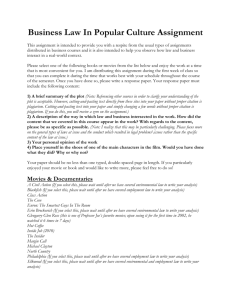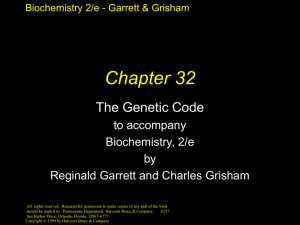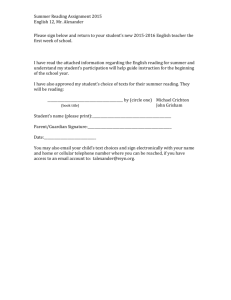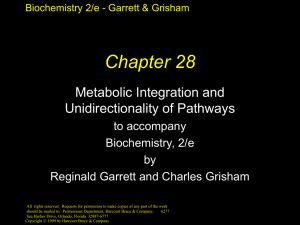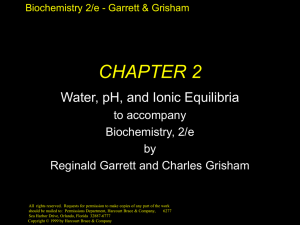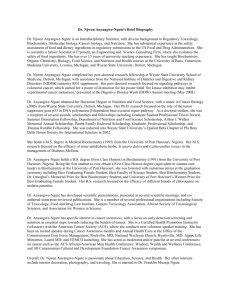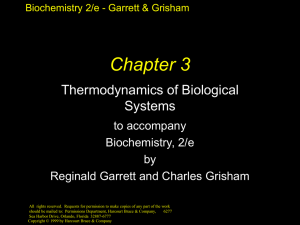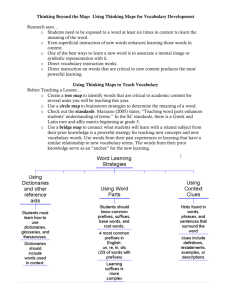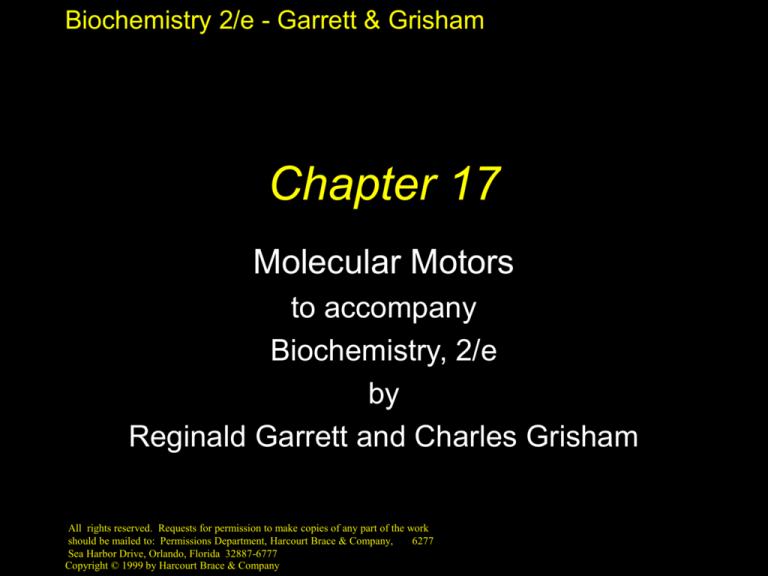
Biochemistry 2/e - Garrett & Grisham
Chapter 17
Molecular Motors
to accompany
Biochemistry, 2/e
by
Reginald Garrett and Charles Grisham
All rights reserved. Requests for permission to make copies of any part of the work
should be mailed to: Permissions Department, Harcourt Brace & Company,
6277
Sea Harbor Drive, Orlando, Florida 32887-6777
Copyright © 1999 by Harcourt Brace & Company
Biochemistry 2/e - Garrett & Grisham
Outline
• 17.1 Molecular Motors
• 17.2 Microtubules and Their Motors
• 17.3 Skeletal Muscle Myosin and
Muscle Contraction
• 17.4 A Proton Gradient Drives the
Rotation of Baterial Flagella
Copyright © 1999 by Harcourt Brace & Company
Biochemistry 2/e - Garrett & Grisham
Tubulin and Microtubules
•
•
•
•
Fundamental components of the eukaryotic
cytoskeleton
Microtubules are hollow, cylindrical
polymers made from tubulin dimers
13 tubulin monomers per turn
Dimers add to the "plus" end and dissociate
from the "minus" end as in Figure 17.3
Microtubules are the basic components of
the cytoskeleton and of cilia and flagella
• Cilia wave; flagella rotate - ATP drives both!
Copyright © 1999 by Harcourt Brace & Company
Biochemistry 2/e - Garrett & Grisham
Copyright © 1999 by Harcourt Brace & Company
Biochemistry 2/e - Garrett & Grisham
Copyright © 1999 by Harcourt Brace & Company
Biochemistry 2/e - Garrett & Grisham
Microtubules in Cilia &
Flagella
• MTs are the fundamental structural unit in
cilia and flagella (see axoneme structure,
Fig 17.5)
• Dynein proteins walk or slide along MTs
to cause bending of one MT relative to
another
• Dynein movement is ATP-driven
• See Figures 17.6 and 17.7
Copyright © 1999 by Harcourt Brace & Company
Biochemistry 2/e - Garrett & Grisham
Copyright © 1999 by Harcourt Brace & Company
Biochemistry 2/e - Garrett & Grisham
Copyright © 1999 by Harcourt Brace & Company
Biochemistry 2/e - Garrett & Grisham
Copyright © 1999 by Harcourt Brace & Company
Biochemistry 2/e - Garrett & Grisham
Microtubules
•
•
•
•
Highways for "molecular motors"
MTs also mediate motion of organelles
and vesicles through the cell
In axons, dyneins move organelles + to -,
i.e., toward the nucleus
Kinesins move organelles - to + , i.e.,
away from the nucleus
See Figure 17.8 and compare (a) and (b)
Copyright © 1999 by Harcourt Brace & Company
Biochemistry 2/e - Garrett & Grisham
Copyright © 1999 by Harcourt Brace & Company
Biochemistry 2/e - Garrett & Grisham
Copyright © 1999 by Harcourt Brace & Company
Biochemistry 2/e - Garrett & Grisham
Polymerization Inhibitors
Therapeutic agents for gout and cancer
• Colchicine, from autumn crocus, inhibits MT
polymerization, mitosis and also white cell
movement - it is a remedy for gout and an
inducer of larger, healthier plants
• Vinblastine, vincristine also inhibit MT
polymerization - anticancer agents
• Taxol, from yew tree bark, stimulates
polymerization, stabilizes microtubules and
inhibits tumor growth, (esp. breast and
ovarian)
Copyright © 1999 by Harcourt Brace & Company
Biochemistry 2/e - Garrett & Grisham
Copyright © 1999 by Harcourt Brace & Company
Biochemistry 2/e - Garrett & Grisham
Morphology of Muscle
•
•
•
•
Four types: skeletal, cardiac, smooth and
myoepithelial cells
A fiber bundle contains hundreds of myofibrils
that run the length of the fiber
Each myofibril is a linear array of sarcomeres
Each sarcomere is capped on ends by a
transverse tubule (t-tubule) that is an extension
of sarcolemmal membrane
Surfaces of sarcomeres are covered by SR
Copyright © 1999 by Harcourt Brace & Company
Biochemistry 2/e - Garrett & Grisham
Copyright © 1999 by Harcourt Brace & Company
Biochemistry 2/e - Garrett & Grisham
Copyright © 1999 by Harcourt Brace & Company
Biochemistry 2/e - Garrett & Grisham
What are t-tubules and SR for?
The morphology is all geared to Ca release
and uptake!
• Nerve impulses reaching the muscle
produce an "action potential" that
spreads over the sarcolemmal
membrane and into the fiber along the ttubule network
Copyright © 1999 by Harcourt Brace & Company
Biochemistry 2/e - Garrett & Grisham
What are t-tubules and SR for?
The morphology is all geared to Ca release
and uptake!
• The signal is passed across the triad
junction and induces release of Ca2+ ions
from the SR
• Ca2+ ions bind to sites on the fibers and
induce contraction; relaxation involves
pumping the Ca2+ back into the SR
Copyright © 1999 by Harcourt Brace & Company
Biochemistry 2/e - Garrett & Grisham
Molecular Structure of Muscle
Be able to explain the EM in Figure 17.12 in terms of
thin and thick filaments
• Thin filaments are composed of actin polymers
• F-actin helix is composed of G-actin monomers
• F-actin helix has a pitch of 72 nm
• But repeat distance is 36 nm
• Actin filaments are decorated with tropomyosin
heterodimers and troponin complexes
• Troponin complex consists of: troponin T (TnT),
troponin I (TnI), and troponin C (TnC)
Copyright © 1999 by Harcourt Brace & Company
Biochemistry 2/e - Garrett & Grisham
Copyright © 1999 by Harcourt Brace & Company
Biochemistry 2/e - Garrett & Grisham
Copyright © 1999 by Harcourt Brace & Company
Biochemistry 2/e - Garrett & Grisham
Copyright © 1999 by Harcourt Brace & Company
Biochemistry 2/e - Garrett & Grisham
Copyright © 1999 by Harcourt Brace & Company
Biochemistry 2/e - Garrett & Grisham
Structure of Thick Filaments
•
•
•
•
•
Myosin - 2 heavy chains, 4 light chains
Heavy chains - 230 kD each
Light chains - 2 pairs of different 20 kD chains
The "heads" of heavy chains have ATPase
activity and hydrolysis here drives contraction
Light chains are homologous to calmodulin
and also to TnC
See structure of heads in Figure 17.16
Copyright © 1999 by Harcourt Brace & Company
Biochemistry 2/e - Garrett & Grisham
Copyright © 1999 by Harcourt Brace & Company
Biochemistry 2/e - Garrett & Grisham
Repeating Elements in Myosin
The secret to ultrastructure
• 7-residue, 28-residue and 196-residue
repeats are responsible for the organization
of thick filaments
• Residues 1 and 4 (a and d) of the sevenresidue repeat are hydrophobic; residues
2,3 and 6 (b, c and f) are ionic
• This repeating pattern favors formation of
coiled coil of tails. (With 3.6 - NOT 3.5 residues per turn, a-helices will coil!)
Copyright © 1999 by Harcourt Brace & Company
Biochemistry 2/e - Garrett & Grisham
Copyright © 1999 by Harcourt Brace & Company
Biochemistry 2/e - Garrett & Grisham
More Repeats!
• 28-residue repeat (4 x 7) consists of
distinct patterns of alternating side-chain
charge (+ vs -), and these regions pack
with regions of opposite charge on
adjacent myosins to stabilize the filament
• 196-residue repeat (7 x 28) pattern also
contributes to packing and stability of
filaments
Copyright © 1999 by Harcourt Brace & Company
Biochemistry 2/e - Garrett & Grisham
Copyright © 1999 by Harcourt Brace & Company
Biochemistry 2/e - Garrett & Grisham
Associated proteins of Muscle
-Actinin, a protein that contains several
repeat units, forms dimers and contains
actin-binding regions, and is analogous
in some ways to dystrophin
• Dystrophin is the protein product of the
first gene to be associated with muscular
dystrophy - actually Duchennes MD
• See the box on pages 548-549
Copyright © 1999 by Harcourt Brace & Company
Biochemistry 2/e - Garrett & Grisham
Copyright © 1999 by Harcourt Brace & Company
Biochemistry 2/e - Garrett & Grisham
Copyright © 1999 by Harcourt Brace & Company
Biochemistry 2/e - Garrett & Grisham
Dystrophin
New Developments!
• Dystrophin is part of a large complex of
glycoproteins that bridges the inner
cytoskeleton (actin filaments) and the
extracellular matrix (via a protein called laminin)
• Two subcomplexes: dystroglycan and
sarcoglycan
• Defects in these proteins have now been linked
to other forms of muscular dystrophy
Copyright © 1999 by Harcourt Brace & Company
Biochemistry 2/e - Garrett & Grisham
Copyright © 1999 by Harcourt Brace & Company
Biochemistry 2/e - Garrett & Grisham
Copyright © 1999 by Harcourt Brace & Company
Biochemistry 2/e - Garrett & Grisham
The Dystrophin Complex
Links to disease
-Dystroglycan - extracellular, binds to
merosin (a component of laminin) - mutation
in merosin linked to severe congenital
muscular dystrophy
-Dystroglycan - transmembrane protein that
binds dystrophin inside
• Sarcoglycan complex - , , - all
transmembrane - defects linked to limb-girdle
MD and autosomal recessive MD
Copyright © 1999 by Harcourt Brace & Company
Biochemistry 2/e - Garrett & Grisham
The Sliding Filament Model
•
•
•
•
•
Many contributors!
Hugh Huxley and Jean Hanson
Andrew Huxley and Ralph Niedergerke
Albert Szent-Gyorgyi showed that actin and
myosin associate (actomyosin complex)
Sarcomeres decrease length during
contraction (see Figure 17.22)
Szent-Gyorgyi also showed that ATP causes
the actomyosin complex to dissociate
Copyright © 1999 by Harcourt Brace & Company
Biochemistry 2/e - Garrett & Grisham
Copyright © 1999 by Harcourt Brace & Company
Biochemistry 2/e - Garrett & Grisham
Copyright © 1999 by Harcourt Brace & Company
Biochemistry 2/e - Garrett & Grisham
The Contraction Cycle
•
•
•
•
Study Figure 17.23!
Cross-bridge formation is followed by power
stroke with ADP and Pi release
ATP binding causes dissociation of myosin
heads and reorientation of myosin head
Details of the conformational change in the
myosin heads are coming to light!
Evidence now exists for a movement of at least
35 A in the conformation change between the
ADP-bound state and ADP-free state
Copyright © 1999 by Harcourt Brace & Company
Biochemistry 2/e - Garrett & Grisham
Copyright © 1999 by Harcourt Brace & Company
Biochemistry 2/e - Garrett & Grisham
Ca2+ Controls Contraction
•
•
•
•
Ca2+ Channels and Pumps
Release of Ca2+ from the SR triggers
contraction
Reuptake of Ca2+ into SR relaxes muscle
So how is calcium released in response to
nerve impulses?
Answer has come from studies of
antagonist molecules that block Ca2+
channel activity
Copyright © 1999 by Harcourt Brace & Company
Biochemistry 2/e - Garrett & Grisham
Copyright © 1999 by Harcourt Brace & Company
Biochemistry 2/e - Garrett & Grisham
Dihydropyridine Receptor
In t-tubules of heart and skeletal muscle
• Nifedipine and other DHP-like molecules
bind to the "DHP receptor" in t-tubules
• In heart, DHP receptor is a voltage-gated
Ca2+ channel
• In skeletal muscle, DHP receptor is
apparently a voltage-sensing protein and
probably undergoes voltage-dependent
conformational changes
Copyright © 1999 by Harcourt Brace & Company
Biochemistry 2/e - Garrett & Grisham
Copyright © 1999 by Harcourt Brace & Company
Biochemistry 2/e - Garrett & Grisham
Copyright © 1999 by Harcourt Brace & Company
Biochemistry 2/e - Garrett & Grisham
Ryanodine Receptor
The "foot structure" in terminal cisternae of SR
• Foot structure is a Ca2+ channel of unusual
design
• Note structure in Figures 17.27 and 17.28
• Conformation change or Ca2+ -channel activity
of DHP receptor apparently gates the ryanodine
receptor, opening and closing Ca2+ channels
• Many details are yet to be elucidated!
Copyright © 1999 by Harcourt Brace & Company
Biochemistry 2/e - Garrett & Grisham
Copyright © 1999 by Harcourt Brace & Company
Biochemistry 2/e - Garrett & Grisham
Copyright © 1999 by Harcourt Brace & Company
Biochemistry 2/e - Garrett & Grisham
Ca 2+ Regulates Contraction
•
•
•
•
Tropomyosin and troponins mediate the
effects of Ca2+
See Figure 17.29
In absence of Ca2+, TnI binds to actin to
keep myosin off
TnI and TnT interact with tropomyosin to
keep tropomyosin away from the groove
between adjacent actins
But Ca2+ binding changes all this!
Copyright © 1999 by Harcourt Brace & Company
Biochemistry 2/e - Garrett & Grisham
Ca 2+ Turns on Contraction
• Binding of Ca2+ to TnC increases binding
of TnC to TnI, simultaneously decreasing
the interaction of TnI with actin
• This allows tropomyosin to slide down into
the actin groove, exposing myosin-binding
sites on actin and initiating contraction
• Since troponin complex interacts only with
every 7th actin, the conformational
changes must be cooperative
Copyright © 1999 by Harcourt Brace & Company
Biochemistry 2/e - Garrett & Grisham
Copyright © 1999 by Harcourt Brace & Company
Biochemistry 2/e - Garrett & Grisham
Binding of Ca 2+ to Troponin C
•
•
•
•
•
•
Four sites for Ca2+ on TnC - I, II, III and IV
Sites I & II are N-terminal; III and IV on C term
Sites III and IV usually have Ca2+ bound
Sites I and II are empty in resting state
Rise of Ca2+ levels fills sites I and II
Conformation change facilitates binding of TnC
to TnI
Copyright © 1999 by Harcourt Brace & Company
Biochemistry 2/e - Garrett & Grisham
Copyright © 1999 by Harcourt Brace & Company
Biochemistry 2/e - Garrett & Grisham
Smooth Muscle Contraction
No troponin complex in smooth muscle
• In smooth muscle, Ca2+ activates myosin light
chain kinase (MLCK) which phosphorylates
LC2, the regulatory light chain of myosin
• Ca2+ effect is via calmodulin - a cousin of TnC
• Hormones regulate contraction - epinephrine, a
smooth muscle relaxer, activates adenylyl
cyclase, making cAMP, which activates protein
kinase, which phosphorylates MLCK,
inactivating MLCK and relaxing muscle
Copyright © 1999 by Harcourt Brace & Company
Biochemistry 2/e - Garrett & Grisham
Copyright © 1999 by Harcourt Brace & Company
Biochemistry 2/e - Garrett & Grisham
Copyright © 1999 by Harcourt Brace & Company
Biochemistry 2/e - Garrett & Grisham
Smooth Muscle Effectors
•
•
•
•
Useful drugs
Epinephrine (as Primatene) is an over-thecounter asthma drug, but it acts on heart as
well as on lungs - a possible problem!
Albuterol is a more selective smooth muscle
relaxer and acts more on lungs than heart
Albuterol is used to prevent premature labor
Oxytocin (pitocin) stimulates contraction of
uterine smooth muscle, inducing labor
Copyright © 1999 by Harcourt Brace & Company
Biochemistry 2/e - Garrett & Grisham
Copyright © 1999 by Harcourt Brace & Company
Biochemistry 2/e - Garrett & Grisham
Copyright © 1999 by Harcourt Brace & Company
Biochemistry 2/e - Garrett & Grisham
Copyright © 1999 by Harcourt Brace & Company

